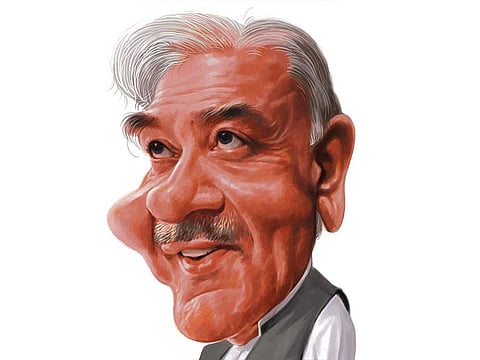Shahbaz Sharif: Tough taskmaster
Pakistan is all set for a change in leadership as Shahbaz Sharif assumes the role of ‘interim president’ of the ruling Pakistan Muslim League-Nawaz

Once nicknamed “Pakistan’s Bobby Kennedy”, after the younger sibling of the former United States president John F. Kennedy, Mian Mohammad Shahbaz Sharif was destined to walk in the footsteps of his elder brother, three-time prime minister of Pakistan, Nawaz Sharif.
But last years’ dismissal of the elder Sharif in a Supreme Court verdict, on a case of unaccounted overseas wealth, has catapulted the younger Sharif to the limelight of Pakistan politics.
Last week’s appointment of Shahbaz as ‘interim president’ of the Pakistan Muslim League-Nawaz (PML-N), the country’s ruling party, has set a process in motion that may eventually see him become the country’s next prime minister, following parliamentary elections due this summer. He is now responsible for the PML-N’s journey into the future — from making key appointments to overseeing a strategy for the elections.
For the past decade, Shahbaz, now in his mid 60s, has ruled Pakistan’s populous Punjab province as the chief minister — a job that may become handy for his next tenure. The chief minister of the province is a politically powerful position in a country where Punjab is home to almost 60 per cent of Pakistan’s population. This has made Punjab a dominant player that easily overshadows Pakistan’s other provinces.
The Sharif brothers have built their power base in Punjab, particularly in Lahore — the provincial capital, where they grew up as the scions of a prominent business family with interests in the steel industry. The family traces its roots to an undivided India before the creation of Pakistan in 1947.
The Sharif family’s large agricultural-cum-residential estate in Lahore’s Raiwind suburb is aptly known as ‘Jati Umra’ — named after the village their parents had left behind on the Indian side of the border during one of the largest human migrations and transfer of populations of the 20th century when India was partitioned in August 1947 to create Pakistan.
After graduating from Government College University, Lahore, Shahbaz joined his family-owned Ittefaq Group. Known for his flamboyant style, he is married to noted author and rights activist Tehmina Durrani.
Over the years, Shahbaz has consolidated his grip over Punjab by building his credentials as an able administrator. “Swim Hard, Dream Big” is just one of the logos on government-sponsored posters prominently displayed in central Lahore to highlight the chief ministers’ activism. With a beaming image of Shahbaz plastered just underneath the logo, the poster highlights the frequently-delivered message.
Senior officials who work closely with Shahbaz describe him as a tough taskmaster with little patience for failure. In recent years, he has frequently travelled to foreign destinations, notably China and Turkey, to woo investments to Punjab. In Lahore, one visible outcome of those journeys is the under-construction ‘Orange line’ train network — an urban mass transit project that aims to drastically reduce travel time for commuters across Pakistan’s second-largest bustling city. Other landmark projects include hospitals for patients in need of cardiac care and kidney treatment.
In spite of what many politicians from the PML-N believe are success stories in Punjab that will give an impetus to Shahbaz’s future political prospects, he faces challenges that could easily undermine him.
One key issue relates to the 2014 killings of 14 opposition protesters in Lahore in a shooting by Punjab police, during Shahbaz’s tenure as chief minister. And last month’s arrest of Ahad Cheema, a civil servant, under investigation in connection with a controversial government property initiative, has raised questions over Cheema’s links with ruling politicians.
In the often-uncertain world of Pakistani politics, such matters could come to haunt key decision-makers. For months before Nawaz’s dismissal last year, many of his political allies played down the significance of the Supreme Court case till close to the final verdict.
The matter of Shahbaz’s political future also depends in part on his ability to steer through claims from other political aspirants. The former prime minister’s daughter, Maryam Nawaz Sharif, has made frequent public appearances along side her father, raising widespread expectations of her emergence as the future political heir to Nawaz Sharif. Additionally, Hamza Shahbaz Sharif, the politically active son of Shahbaz Sharif is widely expected to be another claimant to the top slot.
For now, it is possible that the family may unite and focus on the coming elections to protect their political interests, though the possibility of discord may continue.
Shahbaz Sharif is one of the wealthiest Pakistanis, which leaves him vulnerable from attacks by political foes. In the heat of the race to the next elections, he is sure to face frequent attacks from the likes of Imran Khan, the former cricket star-turned politician and the most ardent opponent of the PML-N and the Sharif brothers. Imran has built his reputation as the principal agitator in pointing towards the Sharif family’s “ill gotten” wealth.
And like the emergence of evidence on their offshore wealth, which came in the widely-publicised ‘Panama papers’, there will always be the possibility of a similar unexpected expose that will throw up new challenges for the Sharif family.
Yet, by all accounts, from across the diverse world of Pakistani politics, one reality is clear: Shahbaz Sharif remains the best choice for the PML-N if it seeks to remain together and retain power in the general elections this year.
One of the most strategic countries in South Asia looks all set to get a new leader.
Farhan Bokhari is a Pakistan-based commentator who writes on political and economic matters.
Sign up for the Daily Briefing
Get the latest news and updates straight to your inbox



